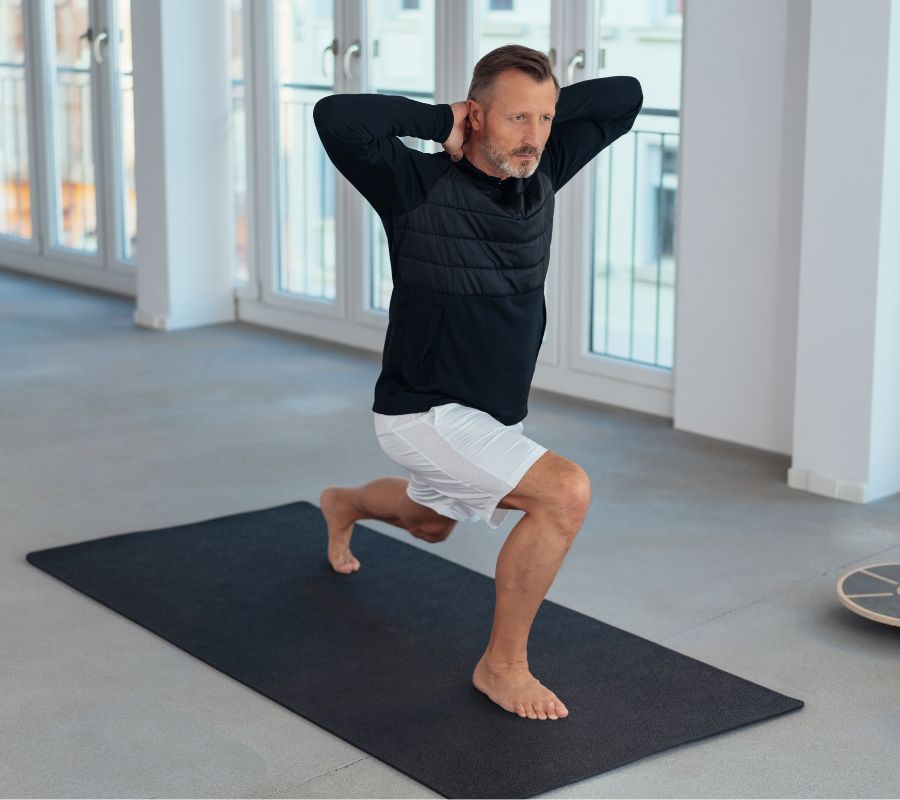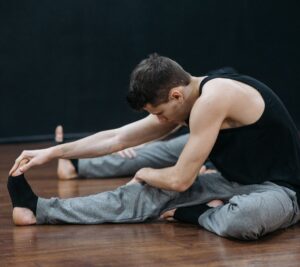Calf stretches are essential for relieving tight muscles and preventing injury. Tight calves can lead to discomfort, poor posture, and even pain in your lower back and knees.
In fact, a study found that over 40% of people experience calf tightness at some point in their lives, often due to sedentary lifestyles or overuse in physical activities.
For example, regularly stretching the calves can decrease the likelihood of strains, as research shows that individuals who stretch consistently reduce their risk of injury by up to 30%. Moreover, these stretches can be done in just a few minutes a day, making them an easy addition to your fitness routine. Sounds good, right?
In this way, you can keep your calves strong, flexible, and free from discomfort.
Here are the best stretches to keep your calves healthy and strong.
Your Calf Muscles
Your calf muscles are made up of two main muscles: the gastrocnemius and the soleus. The gastrocnemius is the more superficial muscle and makes up the bulk of your calf. Underneath it is the deeper soleus muscle which provides stability to your lower leg.
These muscles are attached to your heel by the Achilles tendon which transfers the force generated by the calf muscles to allow movement. Think of the Achilles tendon as a strong connector that allows you to walk, run and jump.
Your calf muscles are involved in your daily mobility and stability. They work whether you’re walking, running or standing still.
Causes of Tight Calves
Tight calf muscles can be caused by many things. Inactivity leads to stiffness and tightness in muscles. Obesity can also put extra strain and lead to cramps and tight calves.
Here are a few more reasons why you might have tight calves:
- Intensive exercise which can lead to calf strains and discomfort.
- Certain medications like diuretics and some cold medications can contribute to muscle tightness.
- Deficiency in minerals like magnesium or potassium can cause muscle cramps and tightness.
Sometimes tightness in the calves can be a sign of more serious conditions like peripheral vascular disease or deep vein thrombosis.
How to Stretch Calves
Calf muscle stretching regularly can increase flexibility and reduce injury. Try the standing calf stretch: hold onto a chair, keep one leg straight with the heel on the floor, bend your front knee and lean forward until you feel the stretch.
Another one is the wall stretch. Stand facing a wall, hands on it. Step back with one leg, heel on the ground, knee straight and lean into the wall to stretch the calf, especially the deeper soleus muscle.
Hold each stretch for 30-60 seconds and then switch legs to make sure both calves are stretched evenly. Foam rolling before stretching can help release tightness in the calves and make your stretches more effective.
Benefits of Calf Stretches
Calf stretches regularly can: increase flexibility in the calf muscles and Achilles tendon, improve range of motion in ankles and feet and reduce the risk of strains and injuries.
Here are the benefits we listed just for you:
- Flexibility in the calves and ankles.
- Reduced risk of calf strains and injuries.
- Better athletic performance in running and jumping.
- Prevention of Achilles tendon injuries.
- Better blood flow in the calves.
- Reduced muscle cramps and tightness.
- Faster recovery and reduced inflammation.
- Overall mobility and stability.
- Prevention of shin splints and plantar fasciitis.
- Calf muscle endurance.
Calf muscles help the foot to flex and propel the body forward for walking, running and jumping.
You’ve got enough information already, so now let’s take a look at the best calf stretches for tight muscles.
1. Standing Wall Stretch
The Standing Wall Stretch targets your calf muscles. Place one foot against the wall, lean forward gently, keep your back leg straight and make sure you feel the stretch in your calf.
Hold for 30-60 seconds and then switch legs to increase calf muscle endurance. This stretch targets both the gastrocnemius and soleus muscles.
Adding the Standing Wall Stretch to your routine can release tightness and prep the muscles for more intense activities, performance.
2. Seated Towel Stretch
The Seated Towel Stretch can release calf tightness. Sit, extend one leg, loop a towel around the foot and gently pull the toes towards you to stretch the calf muscle and connective tissue.
Do this on both legs for balance. Keeping the knee straight while pulling the toes will maximize the stretch and release tightness.
3. Heel Drop on a Step
The Heel Drop on a Step stretches the calf muscles and Achilles tendon. Stand on the edge of a step with the balls of your feet on the step and your heels hanging over the edge. Slowly lower your heels, feel the stretch and hold for 15-30 seconds then return to the starting position.
This stretch increases flexibility, blood flow and helps prevent shin splints and plantar fasciitis. It’s good for those who are into activities that stress the lower legs.
Adding the Heel Drop stretch to your routine keeps your calves healthy and injury free.
4. Downward Dog Variation
The Downward Dog Variation stretches your calf muscles and also works on your hamstrings. Lift your hips and keep your legs straight for the stretch.
For a deeper calf stretch, bend one knee and keep the other leg straight. Alternating foot pedaling can also stretch both calf and hamstrings.
5. Foam Roller Calf Massage
Foam rolling can release tight calf muscles. Place the foam roller under your calf and roll from the Achilles tendon to the knee.
Apply pressure on tender spots for 20-30 seconds to reduce muscle tightness and improve blood flow. This will increase mobility, aid recovery and reduce the risk of Achilles tendonitis and plantar fasciitis.
Adding foam rolling to your routine keeps your calf ready for anything.

6. Dynamic Lunge Stretch
Dynamic lunging stretches the calf muscles and increases flexibility. Stand in a lunge with your back knee low and front knee bent at 90 degrees. Adjust the lunge depth to target different parts of the calf especially the gastrocnemius muscle.
This stretch targets the calf and also engages the hip flexors and quadriceps, a full lower body stretch. Alternating between stretching and contracting will increase flexibility and strength in your legs.
Bottom Line
In short, knowing your calf muscles and the reasons for tightness is the first step to mobility and health. Adding calf stretches to your routine will increase flexibility, reduce injury risk and overall performance.
So go ahead and try these stretches and feel the difference in your calves. Your legs will appreciate the extra love.
Frequently Asked Questions
What causes extremely tight calves?
Extremely tight calves are often caused by rapidly increasing your training intensity or distance without enough rest, along with poor ankle mobility. Make sure to gradually ramp up your workouts and incorporate stretches to help relieve that tightness!
How do you loosen tight calves?
To loosen tight calves, try using a foam roller by rolling back and forth on your lower leg, or stretch by keeping one leg back with the heel flat and bending your front knee to feel the stretch.
Can calf stretches help with plantar fasciitis?
Absolutely! Calf stretches can improve flexibility and reduce strain, which helps ease the symptoms of plantar fasciitis.


